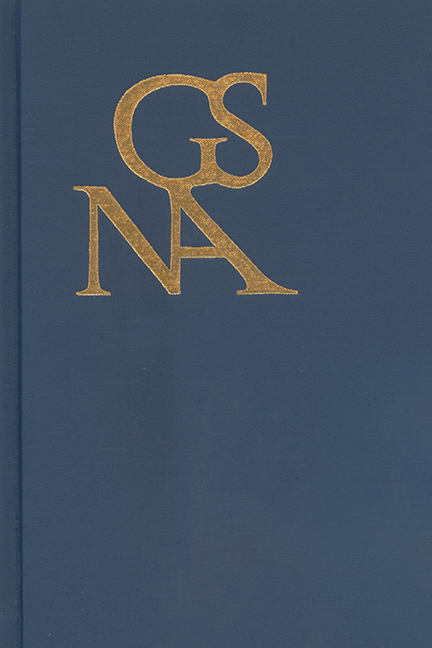Book contents
- Frontmatter
- Contents
- Building Bridges: Goethe's Fairy-Tale Aesthetics
- Goethe as Mystagogue
- Observing Neutrality, circa 1800
- Goethe, Faust, and Motherless Creations
- Impossible Ideals: Reconciling Virginity and Maternity in Goethe's Werther
- Kant, Calculus, Consciousness, and the Mathematical Infinite in Us
- The Classical Aesthetics of Schlegel's Lucinde
- Special Section on Visual Culture in the Goethezeit
- Acquaintance with Color: Prolegomena to a Study of Goethe's Zur Farbenlehre
- “Hamiltonian-Hendelian” Mimoplastics and Tableau of the Underworld: The Visual Aesthetics of Goethe's 1815 Proserpina Production
- J. W. Goethe and C. G. Carus: On the Representation of Nature in Science and Art
- Brentano's Remains: Visual and Verbal Bricolage in Gockel, Hinkel und Gackeleia (1838)
- A Book of Living Paintings: Tableaux Vivants in Goethe's Die Wahlverwandtschaften (1809)
- Book Reviews
Brentano's Remains: Visual and Verbal Bricolage in Gockel, Hinkel und Gackeleia (1838)
from Special Section on Visual Culture in the Goethezeit
Published online by Cambridge University Press: 25 February 2017
- Frontmatter
- Contents
- Building Bridges: Goethe's Fairy-Tale Aesthetics
- Goethe as Mystagogue
- Observing Neutrality, circa 1800
- Goethe, Faust, and Motherless Creations
- Impossible Ideals: Reconciling Virginity and Maternity in Goethe's Werther
- Kant, Calculus, Consciousness, and the Mathematical Infinite in Us
- The Classical Aesthetics of Schlegel's Lucinde
- Special Section on Visual Culture in the Goethezeit
- Acquaintance with Color: Prolegomena to a Study of Goethe's Zur Farbenlehre
- “Hamiltonian-Hendelian” Mimoplastics and Tableau of the Underworld: The Visual Aesthetics of Goethe's 1815 Proserpina Production
- J. W. Goethe and C. G. Carus: On the Representation of Nature in Science and Art
- Brentano's Remains: Visual and Verbal Bricolage in Gockel, Hinkel und Gackeleia (1838)
- A Book of Living Paintings: Tableaux Vivants in Goethe's Die Wahlverwandtschaften (1809)
- Book Reviews
Summary
THE GERMAN ROMANTIC POET Clemens Brentano published two versions of the fairy tale Gockel, Hinkel, Gackeleia, in 1811 and 1838, the latter, greatly expanded work, with an extravagantly lengthy programmatic preface outlining an aesthetic of what I shall call here “remaindering”—an assemblage of human, doll, and animal forms inspired by “Gerümpel,” his grandmother's moldering collection of clothing scraps, jewelry, dried flowers, Christmas decorations, and cut-out pictures. Addressing his “Großmütterchen” (who is in reality the middle-aged Marianne von Willemer), the author describes his collage method for framing his tale within what is itself also a paratextual frame, the “Herzliche Zueignung.” He is using scraps already cut out and recombined once before, cycling back to their origins:
… ja, du Kränzewinderin, Kronenbinderin, Sträußerkräuslerin, aus deinen vielen getrockneten Blumensammlungen habe ich gestohlen, und von dir habe ich gelernt, … diese Blumen dir zur Erheiterung um ein Mährchen herum zu befestigen, wie du sie deinen Freunden mit jenem Gummi, das aus der Rinde der arabischen Acacia vera quillt, um artige Bilder und Reime in schöner Anordnung auf Papier zu heften pflegst. Aus deiner großen Gallerie ausgeschnittener Bildchen habe ich den größten Theil der artigen Figürchen, welche ich hier, gleich dir, in scherz[-] und ernsthafter Combination zu einem Bilderbuche zusammengeklebt habe, und zwar von dir für dich. (8–9)
[… yes, you wreath maker, crown binder, bouquet gatherer, I have stolen from your many collections of dried flowers and I have learned … for your entertainment to glue these flowers around a fairy tale, just as you did for your friends, with that gum that flows out of the bark of the Arabian Acacia vera, by neatly attaching charming pictures and verses to paper. Drawing mostly on your large gallery of cut-out pictures, I have pasted together, as you do, this picture book of neat little images, in a combination that is both playful and serious—coming from you as they do, I dedicate them to you.]
As a child, the author reports, he cut out money from gold paper, and church donations from sugar paper still carrying the traces of the cakes baked on it (14). Yet the actual “scraps” that are cut and pasted into the fairy tale belong as much to the world of high art as to folk art.
- Type
- Chapter
- Information
- Goethe Yearbook 23 , pp. 221 - 244Publisher: Boydell & BrewerPrint publication year: 2016

